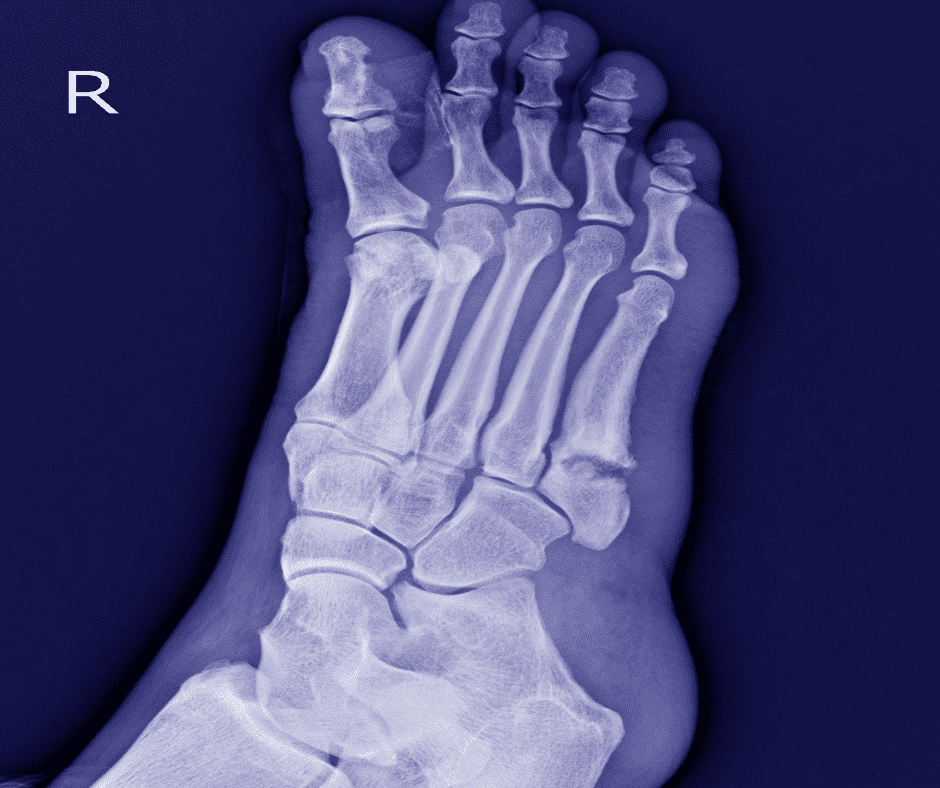The words metatarsal stress fracture is enough to strike fear into the heart of any runner…
…At best you’ll miss weeks of training, and the worst-case scenario is you’ll be on the sidelines for months.
Your foot is made of tiny little bones, called metatarsals. A metatarsal stress fracture is an acute fracture of one of the little bones in your foot. This fracture occurs due to overuse or poor foot biomechanics.
Let’s have a deeper dive into why metatarsal stress fractures happen, the symptoms, and what type of treatment is required…

Cause Of a Metatarsal Stress Fracture
A metatarsal stress fracture is not the most common stress fracture you can get.
What I have found with running injuries over the years is that when our bodies break down, they generally break down at the weakest point.
So what happens is that there’s a long line of stress in the body and it’s the part of the body that’s unable to deal with that stress that breaks down and sometimes the stress fractures include the metatarsals.
Stress fractures, in general, are primarily an overuse injury but many factors play into the causes of getting a metatarsal stress fracture in general:
- Stress fractures in sports are often caused by a repetitive force that is applied over a long time.- That is why runners who run long distances often suffer from metatarsal fractures.
- Metatarsal stress fractures are often caused by being in the incorrect shoes.
- The surface you run on would also play a big role in developing a stress fracture in your foot. If you’re training on hard paving all the time that would put you at a higher risk of developing any type of stress fracture.
- Building up your mileage too quickly can also put your body under enormous strain that could result in a metatarsal stress fracture.
- Nutrition can also be a contributing factor to developing a metatarsal stress fracture.
If you have really poor nutrition, if you’re extremely underweight or if you have or have had an eating disorder you may be predisposed to getting stress fractures easier.
Marathon runners typically are always trying to lose as much weight as possible, so it’s important to get the balance right of losing weight while still giving your body the nutrients it needs to perform at its best.
When you are underweight and if you aren’t eating properly there is a good chance your nutrition is poor. That then is a contributing factor to stress fractures in general.
Bone Health: What You Absolutely NEED To Know
Now that we know a few of the causes, let’s have a look at the symptoms of a metatarsal stress fracture…
Symptoms Of a Metatarsal Stress Fracture

One of the difficulties in diagnosing a metatarsal stress fracture is that there are varying degrees of pain.
By their very nature, stress fractures are like a dull, underlying, niggly pain.
You’re often not quite sure how serious it is because many times the pain is manageable.
You can often run with metatarsal stress fractures. Quite typically, a metatarsal stress fracture will be quite painful at the start of exercise, and then the pain and discomfort might minimize and sometimes even go away completely during exercise.
And then immediately after exercise, as soon as you start cooling off, the pain will start to return.
They often come on quite slowly over time because they really aren’t that painful, and the pain can come and go, we tend to run on them until we’ve done some real damage.
Metatarsal Stress Fracture: The Early Warning Signs
NB: You shouldn’t ignore any discomfort or pain.
That’s the only way that you might be able to catch something like a metatarsal stress fracture at a pre-stress fracture stage, or what’s called a stress response phase rather than the stress fracture phase.
If you catch it early, you may only need to be out for a couple of weeks, as opposed to potentially 6 to 12 weeks out. Because the metatarsals are a moving part of your body and are weight-bearing, they also tend to heal slower than some of the other stress fractures so you mustn’t ignore any pain.
So… How do we treat it?

How To Treat a Metatarsal Stress Fracture
My suggestion would be to consult a doctor in sports medicine.
You will need to head to a medical center to have scans and X-rays taken of your foot and ankle to confirm that you do have a fracture of one of the metatarsal bones.
If the injury is not soft tissue related but is an actual of the metatarsal you’re probably going to be putting a boot for six weeks.
You’re probably going to only start running another two to four weeks once you’ve come out of the boot.
You’ll probably also be put on a course of steroidal anti-inflammatories which will help with the initial discomfort and reduce some of the inflammation and pain.
You would also need to try and get to the bottom of what caused your metatarsal stress fracture.
This may all sound a bit intimidating but don’t fear… it is preventable!
How To Prevent a Metatarsal Stress Fracture

There are a few things you can do to prevent getting a metatarsal stress fracture
- Analyze your training program (to make sure you aren’t training too much or building up too quickly)
- Check your biomechanics (to make sure there are no real issues in your makeup that are predisposing you to, particularly a metatarsal stress fracture)
- Your nutrition (Eat enough, nutrient-rich foods so that your body is not deficient in nutrients needed for good bone health)
- Check your running gait and make sure you are running in the correct running shoes.
- From time to time, there may be a shoe that for whatever reason, in its design, maybe place stress through a particular of your body.
In the past, I’ve seen a sudden spate of metatarsal stress fractures and on closer inspection, I realized all the athletes were in the same brand and model of running shoe…
The easiest way to figure out if a model of running shoes is causing a particular problem is to simply Google it.
Getting Back Into Running After a Metatarsal Stress Fracture
One of the things about stress fractures is that the bone normally heals very well.
The first thing to do is ensure you are pain-free before returning to running after a metatarsal stress fracture.
The body typically over responds to the site where metatarsal stress fracture occurs so if you allow it to heal properly, it’s unlikely to fracture again.
If it does fracture again, you will need to do some investigations around bone density (This is often an issue in female athletes) and really dig into past nutritional practices.
As part of that rehabilitative process, you also want to strengthen all the muscles that are in particular required for running.
Primarily you want to strengthen your glutes, quads, and hamstrings. (This strength training plan will help you strengthen the muscles you need to strengthen to avoid injury)




Comments are closed.